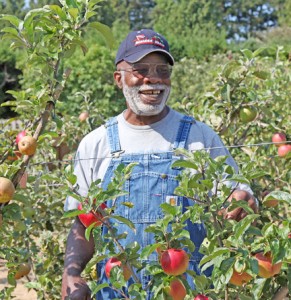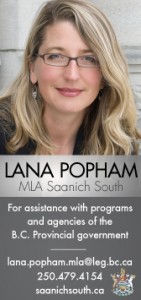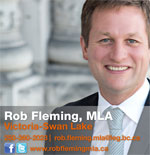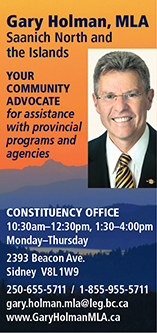Archive for October 2014
Saanich’s Big Issues?
Is this an election or simply a performance review?
by Michele Murphy, photos from Facebook
When there is an issue on the table that is likely to make a significant difference in the pocketbook of the electorate, they are more likely to show up to vote.
While Saanich’s Nov. 15 municipal election may not enjoy the same turn-out that Scotland’s did (84.5% for those of you that missed it), and its issues may not be as big as forming a separate country (Republic of Saanich?), Saanich may be facing larger concerns than it has in the recent past – and as such – attract a larger voter response – or will it?
“The major issues were just starting to brew last election,” says Saanich mayoral candidate Richard Atwell. “They have now become the focus of this election,” he adds.
Mayor Frank Leonard would not comment at this time on whether the municipality faces what he feels are ‘big’ issues. He did say that he approaches elections as more of a performance review. “The residents and I discuss how I have worked with Council and the community to achieve our goals,” he explains.
When asking Atwell what the major issues in Saanich are he responds, “Sewage treatment, amalgamation and CRD governance now take centre-stage. We have reached an impasse on all three and in order to move ahead, we need new faces on Saanich Council. We can no longer keep kicking-the-can down the road.”
Saanichites have a history of being ballot-box averse in municipal elections. The 2005 and 2008 elections saw only 19 and 21% of eligible voters show up to make their mark. Even the 2011 election – an election that saw a significant mayoral candidate come forward to challenge the often-acclaimed Mayor – only saw a minimal improvement over previous elections with 75 per cent of voters choosing to stay home.
The media-of-the-day framed the 2011 campaign that saw retired Saanich South MLA and former (three-times elected) Saanich municipal councillor David Cubberley bid for Saanich’s top-job as primarily a popularity contest naming no substantive issues facing the electorate.
Could it be the disinterest in the democratic process was a result of asking the public to play judge in a personality contests instead of thoughtfully considering the actual issues facing their community?
Let’s take a look at some of the issues that have been identified:
Sewage Treatment:
Atwell comes to the race as the founder and organizer of both Stop a Bad Plan and The RITE Plan, two organizations that were born out of a frustration with the sewage treatment plan that the CRD has created.
Atwell says, “The sewage project in present form will come with a substantial and long-term tax increase which will ultimately impact everything else that we want to achieve in Saanich. We cannot afford to pass this debt onto the next generation and so we must find a better value solution, but so far no one on council is looking.”
Leonard told the Victoria Times Colonist last May that he feels that, “The Capital Regional District should go back to the province for help in finding a solution to its sewage treatment dilemma – only this time it should knock on a different door.” Adding that he felt that given the number of years Saanich has been at this and the circumstances it finds itself in, having the government’s help to move to the next stage would be worthwhile.
Amalgamation:
On amalgamation Leonard told Saanich Voice Online, “The current campaign to reduce the number of small municipalities is not a debate Saanich need be a part of.”
Atwell says that he supports asking the province to study amalgamation. “The public wants to weigh-in with their opinion but so far Mayor Frank Leonard and the rest of Saanich Council have refused to allow even a question on the municipal ballot,” says Atwell, adding, “that’s undemocratic.”
CRD Governance
Leonard was quoted recently as saying that, “The only government bigger than Saanich around here is the CRD, and that doesn’t help the bigger is better argument either.” Perhaps not a glowing endorsement of our regional problem-solving body.
Atwell feels that the CRD has become dysfunctional with the current players. “CRD decisions affect everything that we do, from transportation solutions to waste management and other infrastructure,” says Atwell. “We must find affordable solutions and for that we need new decision makers who can work collaboratively with others to find them.”
What issues exist and how Saanich mayoral candidates propose that they will lead Saanich through these issues may make a significant difference both in the lives and pocketbooks of
Saanich residents. Are these the issues that matter most to you? What more do the candidates have to say? SVO encourages you to check out the candidate’s websites, send them an email, attend an all-candidates meeting.
Whatever issues are important to you, getting informed and turning up to vote is your best chance to have your say on them. While there won’t be a vote on Saanich becoming its own country there are important issues being decided and you don’t want to be left out.
Go to www.saanich.ca/elections for more info on the Nov 15 Saanich elections. Oct 10th will be the closing of the nomination period, at which time we’ll know all the candidates.
Farming – a Lot
Meet Patrick Sixto – orchardist extraordinaire
Article and photos by Ed Johnson
 “I don’t go out and party too much. I golf and I garden and that’s it.” So says Patrick Sixto, retired welder in North Saanich.
“I don’t go out and party too much. I golf and I garden and that’s it.” So says Patrick Sixto, retired welder in North Saanich.
“So,” I smile, “if it starts with a ‘G’ you do it.”
“Yes, but I figure I had better leave the girls alone,” Patrick laughs.
“We will stick to gardening, then.”
Patrick’s laid back style must come from his childhood in Trinidad where gardening was taught in school and each family grew what they could to supplement their diet. Patrick’s big day came when, as a teenager, he was given his own plot at home to tend. The staples in his garden were corn and cassava, the latter being a starchy root full of vitamins and amino acids grown in tropical and subtropical locations throughout the world. In North America dried cassava is known as tapioca, but the root itself has a panoply of uses which makes interesting reading on Wikipedia.
“My wife and I moved here ten years ago after 23 years in Calgary, and we like it. I just wish I had more land than a city lot to grow more fruit trees–if my wife would let me!”
Patrick is no slouch, though, when it comes to using the land that he’s got. Besides the 65 or so apple trees, he also grows his own onions, garlic, beets, corn, carrots, strawberries, asparagus, blueberries, rasp-berries, peaches, peppers, tomatoes, plums, squash – the list goes on.
The reader may wonder how 65 apple trees could fit on a city lot and still leave room for a house. The answer lies in cordon planting. As can be seen in the accompanying video, Patrick plants his trees in an angled (oblique) cordon with dwarf trees grown at forty-five degrees, just two or three feet apart and allowed to grow no more than five feet high. You can purchase cordons all ready to plant, or if more adventurous, learning the art of grafting rootstock can open up many new possibilities.
“A dozen cordons can easily out-produce a full grown standard apple tree, and they are much easier to pick!”, he explains. “People will be surprised at how much they can grown in a small area. I have 60 plus apple trees in an area of 50 x 100 feet that yields more than 1000 apples
per season.”
The busiest time for Patrick is in the springtime, but he says he averages about three hours a day. “You don’t have to be retired to be a part-time gardener,” he says. The biggest time waster in his opinion is the lawn. Mowing, edging, raking leaves time would be better spent growing food, he feels. “Lawn maintenance takes up more of my time than anything else.”
An automated watering system with drip hoses, on the other hand, is a necessary time saver-and conservation of water is an added bonus. Patrick learned at an early age to be frugal with resources. “It is much different in Trinidad, where we had to save all the rainwater we could in the six month rainy season to get us through the dry season. The barrels we used had to be covered with netting to keep out the mosquitos, and an inspector visited regularly just to make sure.”
“But there are lots of ways to grow food and look after ourselves, I think more and more people seem to be doing it.”
This year Patrick is trying out a new system for preserving apples well into next spring. It uses practically no energy and may even save one appliance from the landfill. He also has a unique method of fertilizing his orchard using a common “bilaterally symmetrical invertebrate.” Do you want to learn how to keep the birds off your strawberries without netting? All of these tips and more can be found in the video which follows.
Thanks Patrick!
The ‘A’ Question
Who’s not asking and why and who’s asking – and what?
by Roger Stonebanks
Some residents in Greater Victoria will vote Nov. 15 on whether they want a study of amalgamation – or to express support for amalgamation. And some won’t. It depends on where we live. And also on what the ballot question actually says.
The amalgamation campaign is being pressed under the banner “Amalgamation Yes” by the Capital Region Municipal Amalgamation Society. (See www.amalgamationyes.ca).
On the Saanich Peninsula, Central Saanich and Sidney residents will have a non-binding referendum but North Saanich council turned down the idea. Saanich council won’t be balloting residents.
Central Saanich voters will face this question on the ballot paper – “Should the District of Central Saanich petition the Province to fund a cost/benefit analysis of an amalgamation of Central Saanich, North Saanich and Sidney? Yes or No.”
Sidney voters will see this on Nov. 15 – “Are you in favour of a provincially-funded study to investigate the feasibility, costs and implications of amalgamating the three municipalities of the Saanich Peninsula?”
Retiring Sidney Mayor Larry Cross and some councillors are opposed to amalgamation but not to asking residents what they think. Amalgamation, said Cross, is “not in the best interests of Sidney.”
North Saanich council will not be putting any question to its residents.
“The main reasons were the opinion of most that amalgamation could only increase municipal cost, increase debt and increase taxes,” Mayor Alice Finall told Saanich Voice Online (SVO).
“With respect to my own opinion, I have had the opportunity to look into the extensive research on this question. This shows, with a number of examples, that contrary to popular belief, amalgamation does not save money but costs money, usually much more than anticipated. It also confirms that satisfactory levels of services tend to drop and access to local representatives is diminished. There are few economies of scale.”
She also said the peninsula municipalities already share certain services, a point echoed by Central Saanich Coun. Zeb King.
Saanich council, it is clear, won’t be putting the issue to residents.
“The current campaign to reduce the number of small municipalities is not a debate Saanich need be a part of,” Saanich Mayor Frank Leonard told SVO.
“We are one of the 10 largest municipalities in BC, are five times the geographic size of Victoria and our population of 115,000 is 40 per cent larger and we have 1,500 employees. The only larger local government in the region is the CRD and many would say that proves bigger isn’t better.
“Should ever a future council want to engage the public on this issue, I’d prefer one where there is factual information and a funded ‘yes’ and ‘no’ side. Currently this year the only information is from the advocates who have funding from the downtown business community.”
Coun. Susan Brice concurred with published comments by Mayor Leonard, in particular this one – “Saanich’s sprawling farms, parks and urban areas, lakes and streams take a small army of 1500 municipal employees and increasing those responsibilities won’t necessarily result in efficiencies.”
Another Saanich councillor, Vic Derman, said Saanich residents have not demonstrated wide support for putting the issue on the ballot and the question that Amalgamation Yes poses (asking if residents are in favour of reducing the number of municipalities) is “far too vague.” He said any decision on some form of amalgamation should be preceded by an “extensive process of public debate on the pros and cons. Only after such a debate could the general public make an informed decision.” Amalgamation Yes, he said, “has given no assurances of such a debate and are certainly not an appropriate organization to conduct one.”
Elsewhere in the region, Victoria (where the question will be, “Are you in favour of reducing the number of municipalities in Greater Victoria through amalgamation”), and Esquimalt and Langford residents, will get to express an opinion. Oak Bay residents might – a notice of motion will be before council on Sept. 29 which was after SVO’s deadline. In the “no vote” or unlikely to hold a vote category are Sooke, Highlands, View Royal, Metchosin and Colwood.
AMALGAMATION – UPDATED
Just as this issue of Saanich Voice Online came out, there were several new developments on the amalgamation question in the Nov. 15 municipal election:
Oak Bay council decided on Sept. 29, after SVO’s deadline, to ask voters on Nov. 15 this question – “Are you in favour of the District of Oak Bay being amalgamated into a larger regional municipality?”
Both votes would be non-binding and require simply “yes” or “no” from voters.
Esquimalt council decided on Sept. 29 (after SVO press-time) to put two non-binding questions to voters:
“1. Are you in favour of the Township of Esquimalt exploring options to achieve efficiencies by further sharing some services with other municipalities? Yes or No.
“2. Are you in favour of exploring the reduction of the number of municipalities within Greater Victoria through amalgamation? Yes or No.”
According to Langford Municipal Hall, they will have the following non-binding question on their November 15th ballot:
“Are you in favour of the City of Langford being amalgamated into a larger regional municipality? YES or NO
North Saanich had a change of heart as well – as of Monday, October 6th – Councillor McBride’s request to Council to consider adding a question regarding amalgamation to the ballot was granted. As a result, the following question will be added to the North Saanich ballot:
“Are you in favour of a study, provincially funded, to investigate the feasibility, costs and implications of amalgamating the municipalities of North Saanich, Central Saanich and Sidney.”
While the District of Saanich will be adding a question to their Nov 15th election ballots, it won’t be a amalgamation question. The Oct 6th Council meeting saw Saanich council unanimously endorsed Mayor Frank Leonard’s proposed addition of the question, “Do you support Council initiating a community-based review of the governance structure and policies within Saanich and our partnerships within the Region?”
Check back here for updates as they come in.











